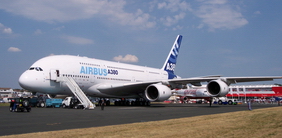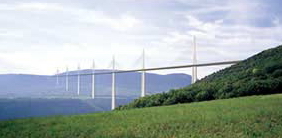As tough as it gets...
 The Airbus A380, a feat of modern engineering technology, is the largest passenger aircraft in the world. In order to minimise the unladen weight, the Airbus 380 incorporates a range of new materials as used on the A318 and A340 families of aircraft. Carbon fibre reinforced plastic is used for the central box of the wings, the horizontal stabilisers, the fin, the rear fuselage section and for
ceiling beams. A new material, Glare, is used in the construction of the panels for the upper fuselage. Glare's aluminium and fibreglass layers do not allow cracks to propagate and the material is much lighter than conventional materials (represents a saving of about 500kg in weight).
The freighter version of the aircraft, the A380F, will have an aluminium-lithium skin on parts of the fuselage and aluminium-lithium in the wings. Aluminium-lithium is stronger than traditional materials, which means a thinner coat can be applied to the fuselage. This leads to further weight savings without loss in strength. Inside the fuselage, the A380F will be the first freighter to have a carbon-fibre barrier wall separating the cockpit and forward section of the aircraft from the cargo area. The carbon-fibre
barrier is lighter than traditional aluminium used in barriers walls and is also corrosion-resistant, meaning no maintenance will be required.
The Airbus A380, a feat of modern engineering technology, is the largest passenger aircraft in the world. In order to minimise the unladen weight, the Airbus 380 incorporates a range of new materials as used on the A318 and A340 families of aircraft. Carbon fibre reinforced plastic is used for the central box of the wings, the horizontal stabilisers, the fin, the rear fuselage section and for
ceiling beams. A new material, Glare, is used in the construction of the panels for the upper fuselage. Glare's aluminium and fibreglass layers do not allow cracks to propagate and the material is much lighter than conventional materials (represents a saving of about 500kg in weight).
The freighter version of the aircraft, the A380F, will have an aluminium-lithium skin on parts of the fuselage and aluminium-lithium in the wings. Aluminium-lithium is stronger than traditional materials, which means a thinner coat can be applied to the fuselage. This leads to further weight savings without loss in strength. Inside the fuselage, the A380F will be the first freighter to have a carbon-fibre barrier wall separating the cockpit and forward section of the aircraft from the cargo area. The carbon-fibre
barrier is lighter than traditional aluminium used in barriers walls and is also corrosion-resistant, meaning no maintenance will be required.
As tall as it gets...
 The Millau bridge in France is the tallest bridge in the world. At 343 metres (1,125 ft) the pillars are slightly taller than the Eiffel Tower and only 38 metres (125 ft) shorter than the Empire State Building. The bridge consists of an eight-span steel roadway supported by seven concrete piers. The roadway itself weighs 36,000 tons and is 2,460 m long, measuring 32 m wide by 4.2 m deep. The
six central spans each measure 342 m with the two outer spans measuring 204 m. The roadway has a slope of 3% descending from south to north and curves in plan section on a 20 km radius to give drivers better visibility. The bridge carries four lanes of traffic and its construction involved sliding the decks out towards each of the piers used satellite-guided hyraulic rams that moved the deck 600 mm every four minutes. The construction of the bridge was completed on-time and without a single serious accident or
fatality.
The Millau bridge in France is the tallest bridge in the world. At 343 metres (1,125 ft) the pillars are slightly taller than the Eiffel Tower and only 38 metres (125 ft) shorter than the Empire State Building. The bridge consists of an eight-span steel roadway supported by seven concrete piers. The roadway itself weighs 36,000 tons and is 2,460 m long, measuring 32 m wide by 4.2 m deep. The
six central spans each measure 342 m with the two outer spans measuring 204 m. The roadway has a slope of 3% descending from south to north and curves in plan section on a 20 km radius to give drivers better visibility. The bridge carries four lanes of traffic and its construction involved sliding the decks out towards each of the piers used satellite-guided hyraulic rams that moved the deck 600 mm every four minutes. The construction of the bridge was completed on-time and without a single serious accident or
fatality.
Note: This website is for tutors and students on courses leading to the award of a BTEC National qualification in Engineering. The material provided here is designed to complement that found in BTEC National Engineering (2nd edition) which covers all six core units of the recently updated Edexcel programme. The book is endorsed by Edexcel and a separate Tutor Support DVD is available.